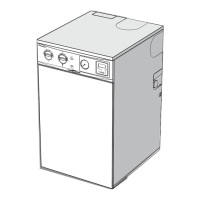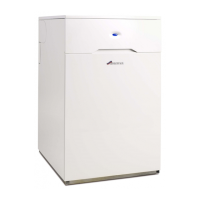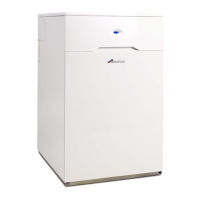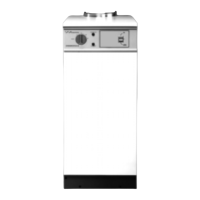30
The pump should operate to allow primary water to flow to the
Heatslave tank. The burner should not operate.
Close the hot tap and set the Domestic Hot Water Control
Thermostat to maximum and the operating switch (or
programmer) to hot water on. The burner and pump should now
operate to allow primary water to flow to the Heatslave tank.
Set the Domestic Hot Water Control Thermostat to the minimum
setting and wait for the burner and pump to switch off. The
Heatslave tank will now be charged to its minimum energy level
and is available for domestic hot water usage.
Fully open a hot water tap. The burner and pump should now
operate and hot water should be available at the hot tap.
With a suitable measuring container, check the water flow rate.
The 12/14 and 15/19 appliances should give a maximum flow
rate of 15 litres/min (± 15%) (3.3 gallons/min)
The 20/25 and 26/32 appliances have no flow restrictor and
the maximum flow rate is dependent on the cold inlet supply
pressure. This can be manually adjusted at the mains cold
water inlet isolating valve. The maximum recommended flow
rate for the 20/25 model is 17 litres/min (3.7 gallons/min).
The maximum recommended flow rate for the 26/32 model is
22 litres/min (4.8 gallons/min).
Fully close the tap and check that the burner and pump switch
off.
NOTE: The burner fan will operate for a further period of 50
seconds when a low level discharge post purge unit is fitted. The
pump may also remain on for a short period if the boiler high
limit thermostat has tripped out and activated the pump
overrun.
Central Heating Mode
Check that all of the radiator valves are open and set the room
thermostat to maximum. Set the Central Heating Control
Thermostat to maximum and turn the Domestic Hot Water
Control Thermostat fully anti-clockwise.
Set the operating switch (or programmer) to heating on and hot
water on. The burner should ignite, the pump should operate
and the diverter valve should open to allow primary water to
flow to the central heating circuit.
Check the system to ensure all of the radiators are heating up
evenly. Balance the system so that the required temperature
difference across the heating flow and return pipes is obtained
relevant to the heating load.
Set the Central Heating Control Thermostat (or room thermostat
fitted) to minimum and check that the burner, pump and
diverter valve switch off.
Domestic Hot Water and Central Heating Mode
Set the Central Heating Control Thermostat to maximum and
turn the Domestic Hot Water Control Thermostat fully anti-
clockwise. Set the operating switch (or programmer) to heating
on and hot water on. Set the room thermostat to maximum. The
burner, pump and diverter valve should all operate allowing
water to be pumped to the central heating circuit.
Set the Domestic Hot Water Control Thermostat to maximum.
The diverter valve should close and divert the flow to the the
Heatslave tank.
16.20 Completion of Commissioning
If the appliance is being passed over to the user immediately,
refer to Section 17 and set the controls to the users
requirements.
If the appliance is to be left inoperative, set the operating switch
(or programmer) to OFF.
Turn off the oil supply at the isolating valve and switch off the
electricity supply.
If there is any possibility of the appliance and system being left
inoperative during frost conditions then drain the appliance and
system.
17.1 Hand the Users Instructions and the Benchmark
Log Book to the user or purchaser for retention; instruct them in
the efficient and safe operation of the appliance and the
heating/hot water system.
17.2 Advise the user or purchaser of the precautions necessary
to prevent damage to the system and to the heating/hot water
system remaining inoperative during frost conditions.
17.3 Finally, advise the user that for continued efficient and safe
operation of the appliance, it is important that adequate
servicing is carried out by a qualified engineer at least once a
year.
17.4 Worcester Heat Systems Limited will be pleased to discuss
and offer a comprehensive maintenance contract.
Set the system controls to the users requirements.
18.1 Routine Servicing
To ensure efficient trouble free operation, the following should
be carried out at least once a year for appliances using 28
second kerosene and twice a year for appliances using 35
second gas oil.
IMPORTANT: Disconnect the electrical supply at the mains
before commencing any servicing. Turn off the oil supply at the
service cock.
1. Carry out a pre-service check and note any operational faults.
2. Check and clean the burner.
3. On the CF model check and clean the air intake grille located
in the boiler room.
4. On the RS balanced flue model check and clean the air intake
ducts at the rear and underneath the boiler and the air intake
grille at the end of the terminal.
5. Check and clean the baffle retainer (20/25 and 26/32 models
only).
6. Check and clean the baffles.
7. Check and clean the heat exchanger surface
8. Check the heatshield (20/25 and 26/32 models only)
9. Check the combustion chamber base insulation board.
10. Check that the flue system is unobstructed and clean as
necessary.
11. If the appliance has been installed in a compartment, check
that the ventilation areas are clear.
12. Clean all oil filters.
Some of the servicing points are covered more fully in the
instructions following:
18.2 Pre-Service Check
1.
Remove the cabinet front and top panels as described in
Section 5.
2. On the RS balanced flue model remove the burner box cover
as described in Section 5.5.
3. Operate the appliance and system. Note any faults which
may need to be corrected during the service.
18.3 Clean the Burner
1.
Remove the burner.
(a) Isolate the electrical supply to the appliance
(b) Isolate the oil supply at both the oil tank and the isolating
valve situated above the burner. (see Fig. 3, 4, 5 and 6).
(c) On the RS balanced flue model remove the burner box cover
by pulling forwards to release the ball studs. This will be found
easier by pulling on one side of the handle first to release two of
the ball studs and then repeating on the other side. Take care
not to pivot the remaining two ball studs too far around as this
will cause damage to the spring clips.
(d) Disconnect the electrical lead from the control box by
depressing the two locking ears on the plug and pulling
downwards.
(e) On the RS balanced flue model feed the electrical lead back
through the grommet seal to give sufficient play to allow
withdrawal and inspection of the burner.
(f) Slacken the two M6 burner locking screws and remove the
burner.
4. Clean the fan impeller using the following procedure:
Electro Oil Inter B9 Burner
(a)
Remove the two screws holding the combustion head in
position and withdraw the combustion head and air guide collar
(where fitted).
18. Routine Cleaning and Inspection
17. Users Instructions

